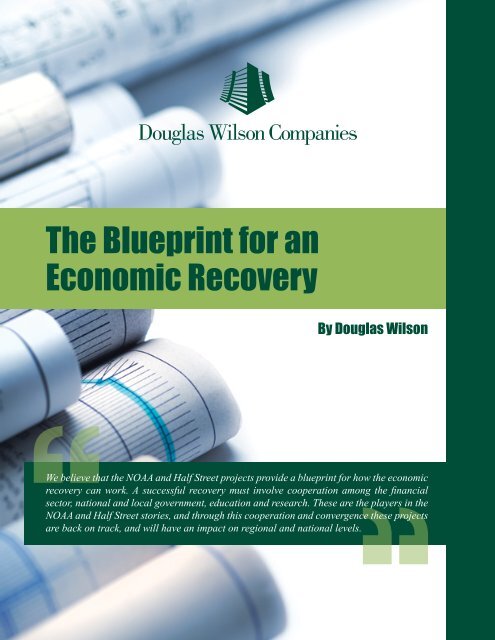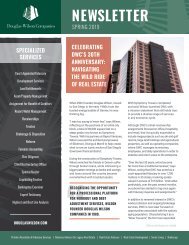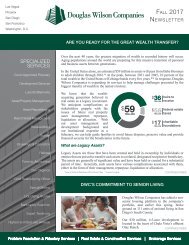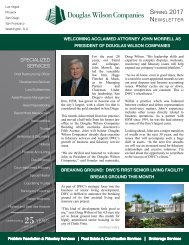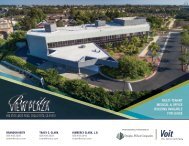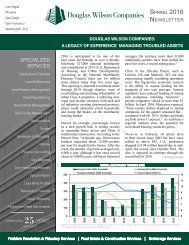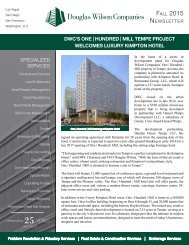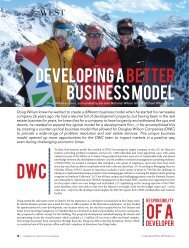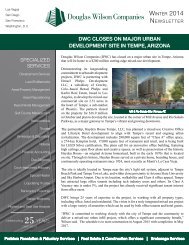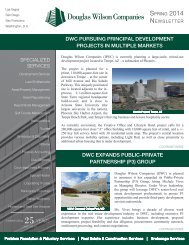The Blueprint for an Economic Recovery
Create successful ePaper yourself
Turn your PDF publications into a flip-book with our unique Google optimized e-Paper software.
<strong>The</strong> <strong>Blueprint</strong> <strong>for</strong> <strong>an</strong><br />
<strong>Economic</strong> <strong>Recovery</strong><br />
By Douglas Wilson<br />
We believe that the NOAA <strong>an</strong>d Half Street projects provide a blueprint <strong>for</strong> how the economic<br />
recovery c<strong>an</strong> work. A successful recovery must involve cooperation among the fin<strong>an</strong>cial<br />
sector, national <strong>an</strong>d local government, education <strong>an</strong>d research. <strong>The</strong>se are the players in the<br />
NOAA <strong>an</strong>d Half Street stories, <strong>an</strong>d through this cooperation <strong>an</strong>d convergence these projects<br />
are back on track, <strong>an</strong>d will have <strong>an</strong> impact on regional <strong>an</strong>d national levels.
<strong>The</strong> <strong>Blueprint</strong> <strong>for</strong> <strong>an</strong><br />
<strong>Economic</strong> <strong>Recovery</strong><br />
Douglas Wilson Comp<strong>an</strong>ies (DWC) has successfully completed two<br />
major building projects—the new home <strong>for</strong> the National Oce<strong>an</strong>ic<br />
<strong>an</strong>d Atmospheric Administration (NOAA) <strong>an</strong>d the Opus East Half<br />
Street office building—that will have a signific<strong>an</strong>t economic impact<br />
in the metropolit<strong>an</strong> Washington, D.C. area.<br />
At the end of the day, NOAA’s National<br />
Centers <strong>for</strong> Environmental Prediction will<br />
provide essential tools <strong>for</strong> the United States<br />
to <strong>an</strong>ticipate <strong>an</strong>d respond to the immediate<br />
threat of a hurric<strong>an</strong>e as well as the long-term<br />
challenges of climate ch<strong>an</strong>ge.<br />
DWC came into the picture <strong>for</strong> both of these projects in 2009, within<br />
two weeks of each other. We knew these buildings had implications<br />
<strong>for</strong> future development in the Washington, D.C. area. We also<br />
understood the complexities of these projects: navigating <strong>an</strong>d<br />
negotiating with a series of interested parties to achieve successful<br />
outcomes.<br />
As the Receiver <strong>for</strong> both of these projects,essentially, we had to<br />
take on the role of developer, working with construction comp<strong>an</strong>ies,<br />
architects <strong>an</strong>d engineers to ensure that the buildings would adv<strong>an</strong>ce<br />
to completion.<br />
<strong>The</strong> NOAA project had signific<strong>an</strong>t challenges. <strong>The</strong> NOAA building<br />
got off to a promising start in 2006 when ground was broken.<br />
However, three years later, amid a series of disputes <strong>an</strong>d lawsuits,<br />
the lease was in default <strong>an</strong>d the project had abruptly stopped.<br />
Taking over as Receiver, we immediately beg<strong>an</strong> discussions with<br />
the U.S. General Services Administration (GSA), the agency<br />
responsible <strong>for</strong> meeting the space requirements of federal<br />
agencies, <strong>an</strong>d B<strong>an</strong>k of America, which provided fin<strong>an</strong>cing <strong>for</strong> the<br />
NOAA building. At the time of the default, the project was nearly<br />
two-thirds complete, but it still required more th<strong>an</strong> $65 million to be<br />
finished.<br />
Our discussions extended to the offices of U.S. Sen. Barbara<br />
Mikulski of Maryl<strong>an</strong>d <strong>an</strong>d U.S. Rep. Steny Hoyer of the 5th<br />
Congressional District of Maryl<strong>an</strong>d which includes the NOAA site.<br />
We also engaged discussions with the University of Maryl<strong>an</strong>d, who<br />
viewed the NOAA building as a vital component of its M-Square<br />
research park, a crossroad where government, private industry,<br />
technology <strong>an</strong>d science converge.<br />
What we saw in the NOAA project was a commitment on the part of<br />
the GSA, B<strong>an</strong>k of America, government officials, education leaders<br />
<strong>an</strong>d the private sector to work out the details of the project. <strong>The</strong>y<br />
all understood that the stakes were high, <strong>an</strong>d were willing to take<br />
intelligent risks to resume the project. Upon successful completion,<br />
NOAA’s National Centers <strong>for</strong> Environmental Prediction will provide<br />
essential tools <strong>for</strong> the United States Government to <strong>an</strong>ticipate <strong>an</strong>d<br />
respond to the immediate threat of a hurric<strong>an</strong>e as well as the longterm<br />
challenges of climate ch<strong>an</strong>ge.<br />
After months of conversations, negotiations <strong>an</strong>d compromises,<br />
DWC was able to get the NOAA building back on track. In<br />
December 2011, NOAA Maryl<strong>an</strong>d LLC purchased the building from<br />
B<strong>an</strong>k of America. <strong>The</strong> 270,000 square-foot building is scheduled to<br />
be occupied this summer.<br />
<strong>The</strong> 400,000 square-foot Opus East Half Street office building is located<br />
in the Capitol Riverfront District of Washington, D.C., two blocks from the<br />
Washington Nationals’ new ballpark <strong>an</strong>d near the U.S. Capitol. As Receiver,<br />
we were responsible <strong>for</strong> coordinating the develpoment <strong>an</strong>d construction<br />
activites of the property. Concurrently, we negotiated the settlement of<br />
numerous mech<strong>an</strong>ics’ lien claims, all in <strong>an</strong> ef<strong>for</strong>t to prepare the property <strong>for</strong><br />
takeout fin<strong>an</strong>cing by <strong>an</strong>other fin<strong>an</strong>cial institution.<br />
<strong>The</strong> project was only about 40 percent built when we took over as<br />
Receiver—less th<strong>an</strong> two years later, it was ready <strong>for</strong> occup<strong>an</strong>cy.<br />
<strong>The</strong> Half Street building, completed in June 2011, was tr<strong>an</strong>sferred to<br />
Prudential Real Estate Investors (PREI ®) in J<strong>an</strong>uary 2012. PREI ® will<br />
oversee the leasing of the office space <strong>for</strong> the building.<br />
<strong>The</strong>re is no question difficult <strong>an</strong>d challenging economic times remain.<br />
This is proven as we encounter projects that have failed <strong>for</strong> one reason<br />
or <strong>an</strong>other each day in our business. A recent USA Today story captured<br />
at once the challenges <strong>an</strong>d promise of the commercial real estate market.<br />
<strong>The</strong> story pointed to a report that lenders “were still saddled with $181<br />
billion in distressed lo<strong>an</strong>s in February, according to Real Capital Analytics<br />
(RCA).” <strong>The</strong> story emphasized, however, that the commercial real estate<br />
market “is turning around far more quickly th<strong>an</strong> <strong>an</strong>alysts expected, with<br />
troubled lo<strong>an</strong>s falling, occup<strong>an</strong>cy rising <strong>an</strong>d office building sales surging<br />
in the largest markets.” What we have seen in the NOAA <strong>an</strong>d Half Street<br />
projects is a promising sign, a sign that through collaboration <strong>an</strong>d a belief<br />
in common ground we c<strong>an</strong> move our economy <strong>for</strong>ward.<br />
What we have seen in the NOAA <strong>an</strong>d<br />
Half Street projects is a promising sign,<br />
a sign that through collaboration <strong>an</strong>d a<br />
belief in common ground we c<strong>an</strong> move<br />
our economy <strong>for</strong>ward.<br />
Opus East Half Street Office Building<br />
Washington, D.C.<br />
About Douglas<br />
Wilson Comp<strong>an</strong>ies<br />
Founded in 1989 <strong>an</strong>d headquartered in S<strong>an</strong><br />
Diego, Douglas Wilson Comp<strong>an</strong>ies is one of the<br />
largest firms of its kind, providing a wide r<strong>an</strong>ge<br />
of specialized business <strong>an</strong>d real estate services to<br />
law firms, state <strong>an</strong>d federal courts, corporations,<br />
partnerships, pension funds, REITs, fin<strong>an</strong>cial<br />
institutions <strong>an</strong>d property owners nationwide.<br />
To date, the comp<strong>an</strong>y has provided problem<br />
resolution <strong>for</strong> assets valued in excess of $12 billion.<br />
For more in<strong>for</strong>mation call 619.641.1141 or visit:<br />
www.douglaswilson.com<br />
PHOTO CREDIT:<br />
Mary Parker Architecture Photography, courtesy of<br />
Sk<strong>an</strong>ska USA Building<br />
National Oce<strong>an</strong>ic <strong>an</strong>d Atmospheric Administration (NOAA) Research Facility<br />
University of Maryl<strong>an</strong>d<br />
www.douglaswilson.com • 619.641.1141
Las Vegas S<strong>an</strong> Diego S<strong>an</strong> Fr<strong>an</strong>cisco Washington, DC<br />
Serving Clients Throughout the United States


